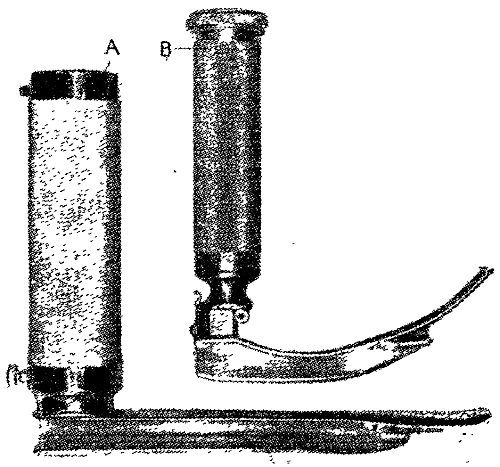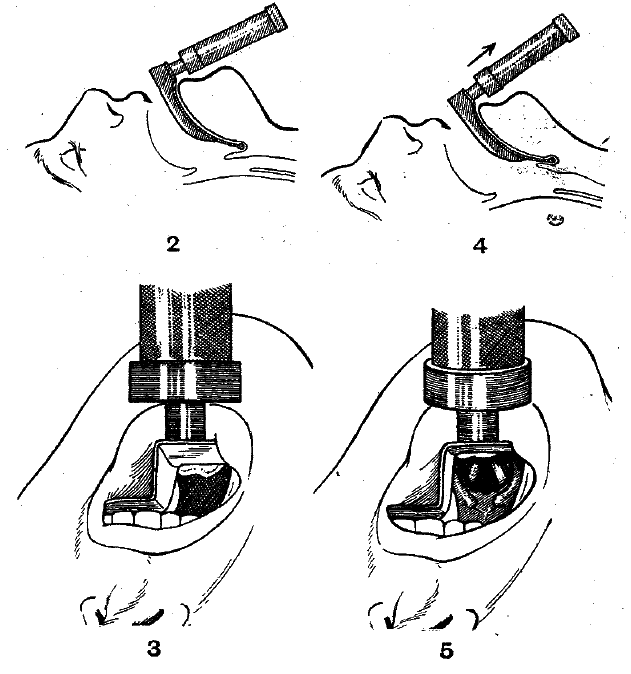Macintosh laryngoscope
Description
In 1943, Sir Robert Reynolds Macintosh (1897–1989) discovered the principle of indirect elevation of the epiglottis and developed the laryngoscope which bears his name.
The Macintosh laryngoscope has a curved blade which allows exposure of the larynx by positioning the tip in the vallecula, anterior to the epiglottis, lifting it out of view.
Macintosh originally designed the laryngoscope to facilitate intubation in unparalyzed patients. In spite of enormous subsequent changes in anaesthetic practice, the Macintosh laryngoscope continues to dominate more than 60 years after its key indication become obsolete.
the Macintosh laryngoscope…probably the most successful ‘durable’ in the history of anaesthesia to date.
Sir Anthony Jephcott, 1983

(A) Standard laryngoscope with long straight blade.
(B) Laryngoscope with short curved blade.
Fig 1. Macintosh RR. Lancet 1943
This laryngoscope is designed to lessen the difficulty of exposing the larynx to pass an endotracheal tube. Normally the long straight blade of the standard laryngoscope (fig. lA) is passed beyond the epiglottis in order to evert it.
The new laryngoscope is designed so that when its short curved blade is in position the tip will fit into the angle made by the epiglottis with the base of the tongue (fig. 2); and a direct view thus obtained (fig. 3). If the laryngoscope is now lifted the base of the tongue will be pushed upwards (fig. 4); the epiglottis, because of its attachment to the base of the tongue, is drawn upwards and the larynx (fig. 5).
Macintosh RR. Lancet 1943

Fig. 4 and 5: Site of blade and view obtained when laryngoscope is lifted in direction of arrow.
Macintosh RR. Lancet 1943
History of the Macintosh laryngoscope
1941 – The Macintosh Laryngoscope was invented by Sir Robert Reynolds Macintosh and developed by Richard Salt (senior technical assistant of his anaesthetic department). Previously the standard laryngoscope blades were straight and were designed to pass beyond the epiglottis, like the modern Miller blade. Macintosh’s blade/technique was believed to be less traumatic and require a lighter level of anaesthesia without causing laryngospasm (this was even more important at the time as muscle relaxants were not available when it was first designed).
Macintosh reasoned that it was the relationship between the epiglottis and the blade that was important in conducting effective laryngoscopy, as he explained to Sir Anthony Jephcott:
Passing an endotracheal tube was quite a tour deforce 50 years ago, or, more specifically, before the introduction of curare which abolished all reflexes…The ability to pass an endotracheal tube under direct vision was the hallmark of the successful anaesthetist. The difficulty was to expose the cords.
One morning during a tonsillectomy list, I had a bit of luck and the nous to take advantage of it. On opening a patient’s mouth with a Boyle-Davis gag I found the cords perfectly displayed. Richard Salt (a really excellent chap) was in the theatre with me; before the morning had finished he had gone out and soldered a Davis blade on to a laryngoscope handle and this functioned quite adequately as a laryngoscope. The important point being that the tip finishes up proximal to the epiglottis. The curve, although convenient when intubating with naturally curved tubes, is not of primary importance as I emphasised subsequently
Macintosh 1983
The curve
During the early development of the eventual design for the Macintosh, the blade was available in different shapes; even some still had a straight blade. Initially Macintosh emphasised that the most important aspect was not passing the blade beyond the epiglottis and lifting it indirectly.
…the precise shape or curve of the blade does not seem to matter much provided that the tip does not go beyond the epiglottis
Macintosh 1944
The blade size
Original Macintosh designed only two sizes of blade – adult and child. Macintosh thought that one size would fit all adults, however the blade was initially used in obstetrics cases (i.e., only in women). Eventually, a larger size was devised, which evolved into the modern Macintosh 4, whereas the original design approximates what became the Macintosh 3.
Subsequently manufacturers produced a Macintosh 2 and Macintosh 1. However, these sizes were not endorsed by Macintosh, with direct laryngoscopy in small children and infants usually is done with straight blades.
The Manufacture and Patent
The blade was first manufactured by Medical and Industrial Equipment Ltd in 1943. Around the same time, three technicians from the Oxford University laboratories formed the The Longworth Scientific Instrument Company Ltd and were making the instrument within a few months for Macintosh’s letter to the Lancet published on 8 April 1944. Initially the blades were pressed by Lord Nuffields company (a friend of Macintosh) but the Longworth Company soon started manufacturing the blades themselves.
Macintosh sent Richard Foregger of New York one of the early models of his new instrument, handmade by Salt, and interest was immediate. The Foregger company also started manufacture in 1943. Unknown to Macintosh (though quoting him as inventor), Foregger applied for a United States patent claiming novelty for the entire form of the blade (granted July 1944). Interestingly the ‘signature’ on the drawings which form part of the patent was evidently appended by the attorney and is mistakenly ‘MacIntosh’ instead of ‘Macintosh’. Not only was the blade seen to be superior to previous versions of laryngoscopes it was also cheaper, further adding to its appeal for anaesthetists at the time (thanks, in part, to the technicians who made up the Longworth Company, as they felt it indecent to make profit from medical equipment)
Macintosh did not pursue patents or royalties on his design
As there was no patent outside of the United States, many other companies began designing their own version of the Macintosh blade. Two versions became the most popular, the English E-Mac and American A-mac. Compared to the E-mac the A-mac has a higher flange and the curve of the blade is not completely continuous.
Welch Alleyn developed the now familiar ‘hook-on’ means of blade attachment, enabling the blade to be removed from the handle when in the folded position. This too was patented, but soon adopted by Foregger who, by 1952, had discontinued all other methods of attachment…
Associated Persons
- Sir Robert Reynolds Macintosh (1897–1989)
Alternative names
- The Mac blade
References
Original articles
- Macintosh RR. A new laryngoscope. Lancet 1943; 241(6233): 205
- Macintosh RR. Laryngoscope blades. Lancet 1944; 243(6293): 485
- Patented July 25, 1944 Laryngoscope. Robert R. MacIntosh, Oxford, England, assignor to The Foregger Company
Review articles
- Jephcott A. The Macintosh laryngoscope. A historical note on its clinical and commercial development. Anaesthesia. 1984; 39(5): 474-9
- Zadrobilek E. Macintosh Laryngoscope. Virtual Museum of Equipment for Airway Management.
- Jephcott A. The Macintosh laryngoscope. A historical note on its clinical and commercial development. Anaesthesia 1984;39:474-479
- Burkle CM et al. A Historical Perspective on Use of the Laryngoscope as a Tool in Anesthesiology. Anesthesiology 2004; 100(4): 1003-1006.
- Minassian H et al. Robert Reynolds Macintosh, M.D. (1897-1989): Forefather of Anesthesiology, Advocate for Patient Safety. 2017
- SCOTT, J. and BAKER, P. How did the Macintosh laryngoscope become so popular?. Pediatric Anesthesia, 2009; 19: 24-29
[cite]
Doctor currently working in South Wales, training in anaesthetics. Graduated Leeds University with MB ChB with BSc in microbiology in relation to medicine. Special interests in emergency medicine, critical care and anaesthetics

